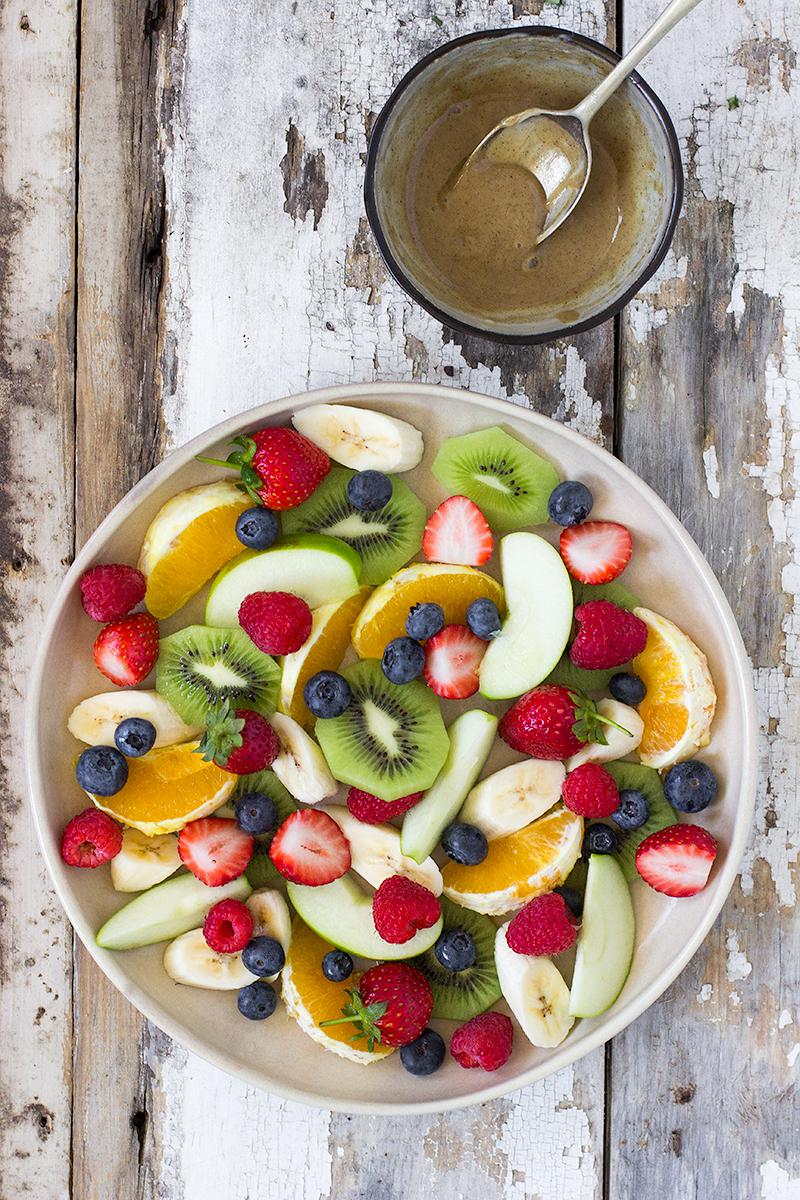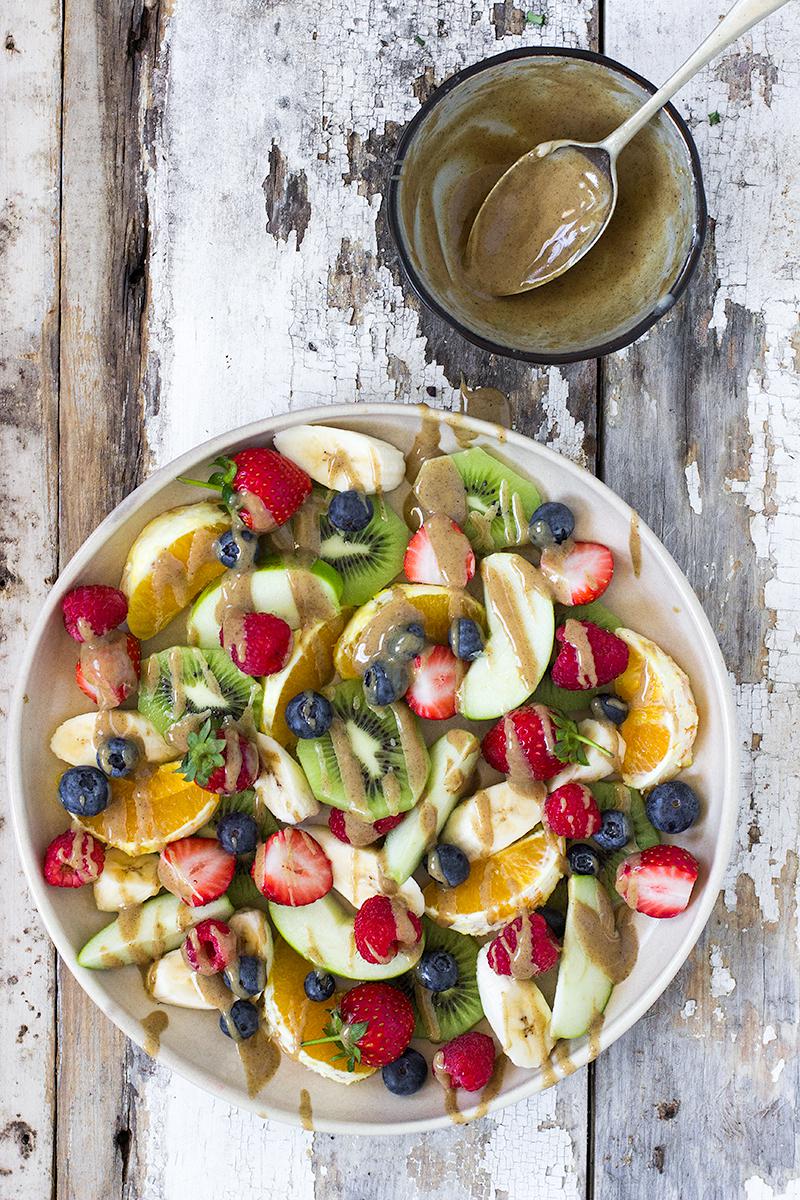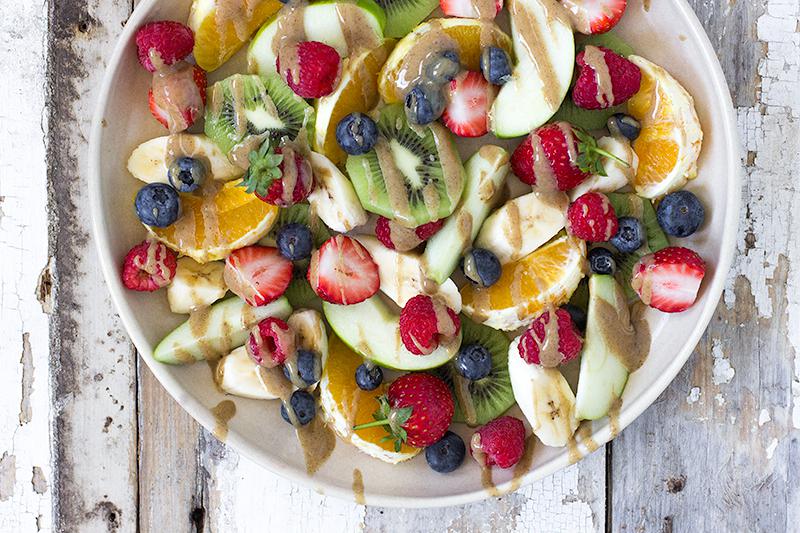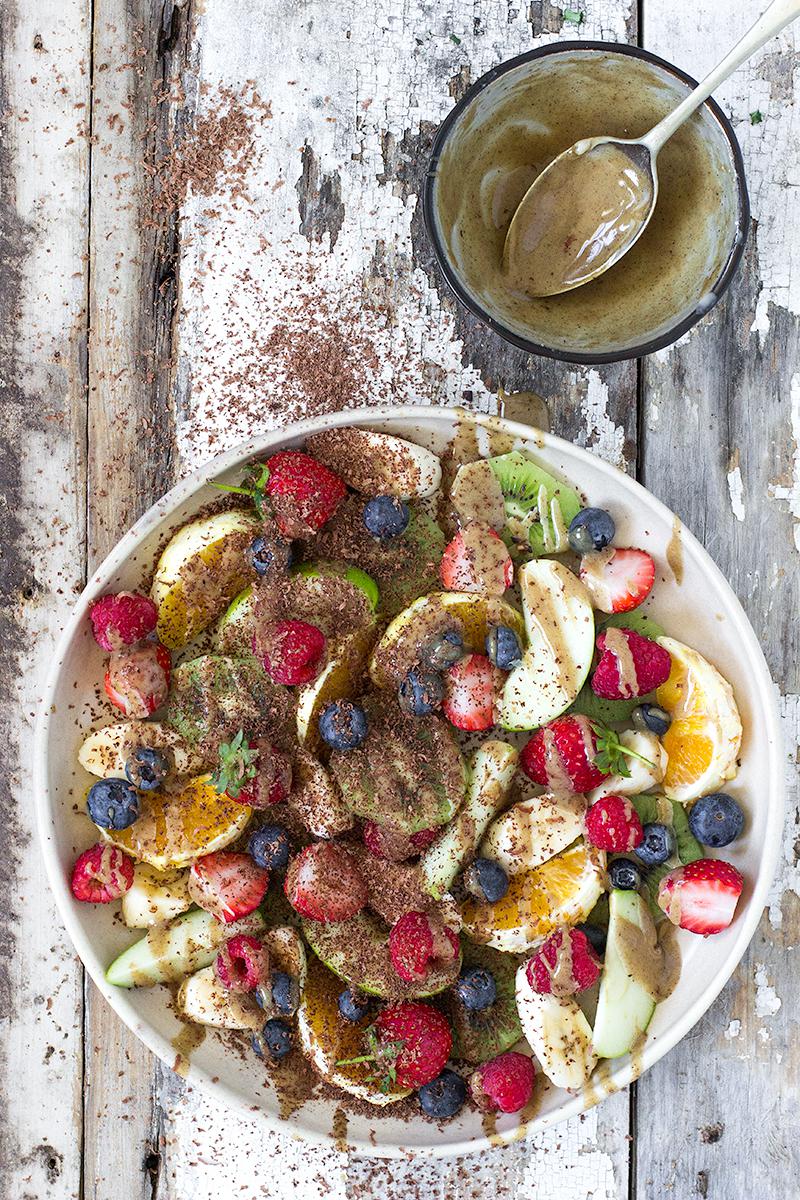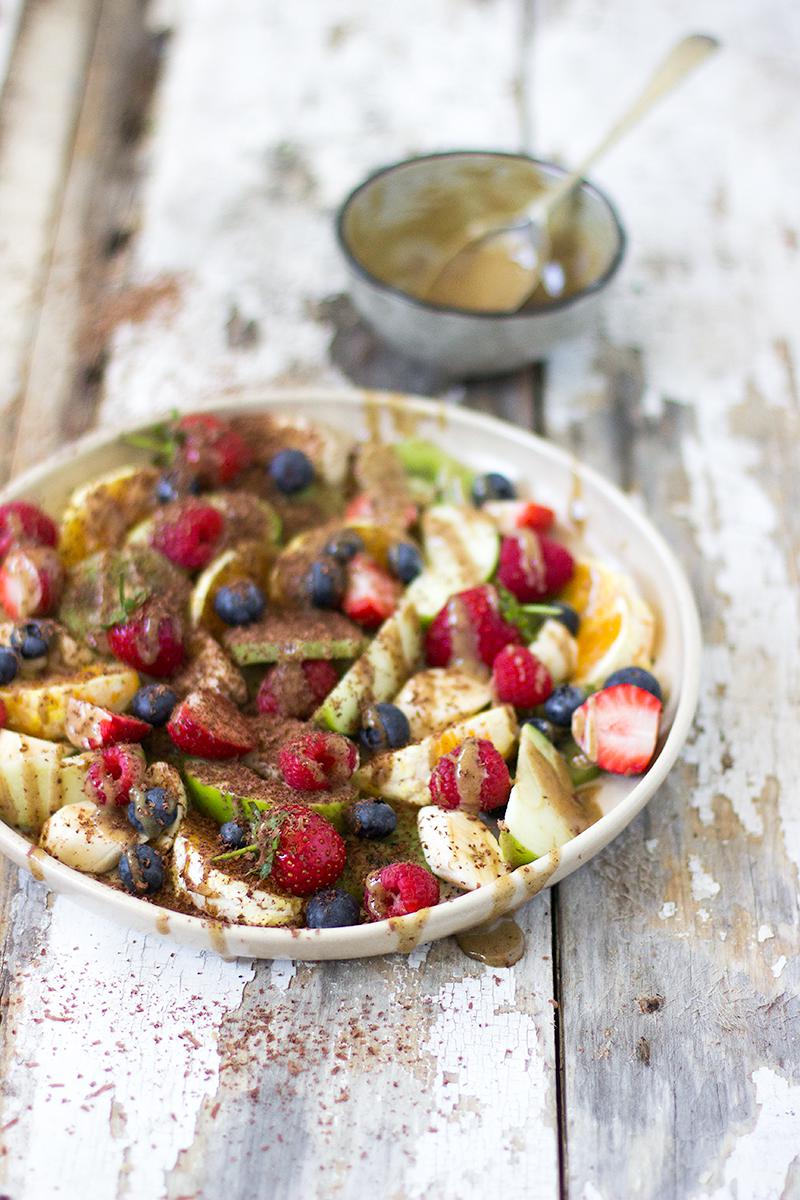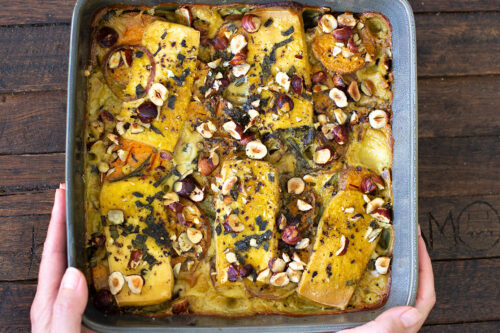
This recipe originally appeared in Nourish Magazine issue 0810.
I’ve broken my promise and bought you another sweet dish. Sorry about that. I’ve had a few dessert dishes tucked away that were originally printed in Nourish Magazine but now the editions have passed I can share the recipes here on the blog. I’ve really wanted to bring you this one in particular, as it’s such an easy dessert that can be shared at the end of a meal between friends and family.
I originally made this for my family years back and also included with it some peanut butter stuffed dates from memory. Its such a light dessert and super interchangeable with any seasonal fruit. I’ve even in winter warmed the fruit first in the oven before drizzle with the tahini caramel and topping with the grated chocolate. I know, good right!
Fruit gets a bit of a bad name these days. At least once a week one of my new clients will ask about whether fruit is ‘bad’ for you, especially bananas, demons spawn apparently. I think we can thank a combination of the IQS movement, the LCHF diet, ketogenic diet and the FODMAP diet combined for these ill placed fears. Of course all of these diets come from a place filled with good intentions, however their food rules placed in the mind of impressionable woman and men (already confused about what to eat) often deliver a message that fruit is ‘bad’ for you, or at least a division of good vs bad.
Take IQS for instance, although the program stipulates they encourage you to just ‘eat real food’, there is a division of fruits between high fructose and low fructose fruits. Realistically unless you have a fructose malapsorption issue, fructose rich fruits are not going to give you any grief. As always its about a well balanced intake of fruit as part as an overall nourishing diet. Whether it’s a handful of blueberries or a mango, the average person is going to breakdown, absorb and assimilate the nutrient from either fruits without the fructose heavier mango sending the body into a fructose meltdown. A mango is not a bottle of high fructose corn syrup.
If one googles ‘LCHF diet + fruit’ articles pop up about the amount of grams of fructose in each fruit and which berries are best to eat for a low carb/ketogenic diet. Banana, apples and oranges are tainted as the worst of the bunch with a high fructose content and ‘lower nutrient viability than berries’. I’ll remember this next time I need some added potassium and ensure I head to berries for providing everything I need. #begonebanana
Can we just clear the air once and for all and say that fruit is not bad for you. Fruit grows on a tree or a vine as nature intended providing a wonderful package of nutrients and fibre. When the majority of us enjoy fruit as part of a diverse wholefood diet then we are only enriching it with all that fruit has to give. Studies do show that high fructose consumption alongside a large am0unt of glucose and starch do lead to health problems such as diabetes, arthrosclerosis and liver disease, however fructose consumed as part of a balanced diet in regulatory amounts is not correlated with these conditions. When we take food, especially something as natural as fruit and create divisions around good and bad we create fear for the general public around eating something as natural as a piece of fruit. As someone who works day in and day out with the public in this space I see that fear too often.
Can we consume too much fruit? Of course! We can consume too much of anything if we really tried hard enough! For instance, if we take fruit and juice it to make litre sized beverages that we chug down every day, or basketball sized fruit ice-creams as meals every morning, then of course our fruit consumption starts to get out of whack. Its not that the fruit is bad, it’s that the person eating all this fruit is just overloading. Your body can only process so much natural sugars in the fruit at one time, therefore over loading it will often lead to bloating and sugar highs and lows. This is poor management of diet, its nothing to do with fruit being the problem.
The thing is, if you are eating a macronutrient balanced diet you won’t consume this much fruit as your meals are put together to work around providing you with all that is needed. It’s hard to overeat fruit (or anything else for that matter) when your meals are balanced. The satiety that’s provided by the combination of complex starchy carbs, protien, fats and the variety of fibre negates any desire to binge on certain food groups.
In regards to limiting fruit, pretty much the only time that we will ask our clients to reduce (or omit) their fruit consumption is short term whilst following a strict gut healing protocol. This is always done under supervision and our intention is to get them back into fruit as soon as possible, with as much variety as achievable.
Of course some people do have true fructose intolerance, but believe me as someone who has worked with intolerances for over a decade, this is far and few between. Usually if someone feels fruit ‘upsets their gut’ it’s a sign that their gut is not right, not that they are intolerant to the fruit.
Personally my favourite fruits (I’m not going singular here because that is just cruel to make me pick one) are bananas, red papaya, raspberries and white nectarines. Oh! Lets not forget the illusive feijoa as well that is so damn hard to get your hands on in Australia. For me, I would eat around 1 -2 pieces of fruit a day, often more so as part of a meal than as a snack. Majority of my clients would either be adding fruit to their breakfast meals or snacking on a piece somewhere within the day. As always, once their dietary intake is macronutrient balanced fruit just naturally falls into a great daily rhythm of intake, because that’s what eating a great balanced diet is all about.
fruit platter w tahini caramel & chocolate
- serves
- serves 4
- preparation time
- 20 minutes
- cooking time
- nil
ingredients
- 1 lady finger banana, sliced
- 1 apple, core removed and sliced
- 1 orange, peeled and segmented
- 2 kiwi fruits, peeled and sliced
- 6 – 8 strawberries
- 1 cup raspberries
- 1 cup blueberries
- 4 squares dark chocolate (at least 75% or more)
- // tahini caramel //
- 1 tablespoon hulled tahini
- 1 tablespoon almond milk
- 1 teaspoon maple syrup
- teaspoon pure vanilla powder or extract
- 1 teaspoon mesquite powder (optional)
method
Start with making the tahini caramel by combining all of the caramel ingredients in bowl and mixing till nice and smooth. Set aside.
Arrange the fruit on a large platter so that all the fruit colours are nicely spread out. When ready to serve drizzle the tahini caramel over the fruit and then grate the chocolate over the fruit platter to finish. Serve in the middle of the table with forks so everyone can eat off the platter together.
nutritional information
- Fruit in its whole natural package provides satiety through a rich supply of fibre, reducing the desire to over consume and therefore increasing fruits overall energy utilisation by the body. Foods such as fruit rich in fibre provide a viscous like gel for the intestines, which creates bulk and additionally slows the movement of food. This provides a feedback mechanism through receptors creating a satiety feeling, consequently reducing the desire for more food and therefore over consumption of sugars seen so commonly with fibre devoid carbohydrates such as refined flours and simple sugars.
- Our gut microbiota is enriched by dietary fibre and polyphenols prevalent in fruit (and of course vegetables too). The fibre and polyphenols abundant in fruit increase the ratio of familys of bacteria (phyla) called bacteroidetes and actinobacteria found to be the predominate communities in lean individuals to firmicutes and proteobacteria which have been found in higher numbers in the obese coming. If you would like to read more about current studies on the effect of fruit in our diet you can read ‘Paradoxical Effects of Fruit on Obesity’ 2016 Satya P. Sharma et al
Jessica Cox is a qualified practicing Nutritionist with a Bachelor Health Science (Nutrition) and over 15 years of clinical experience. She is the founder and director JCN Clinic, published author and established recipe developer. Jessica is well respected within health and wellness space for her no fad approach and use of evidence-based nutrition.

